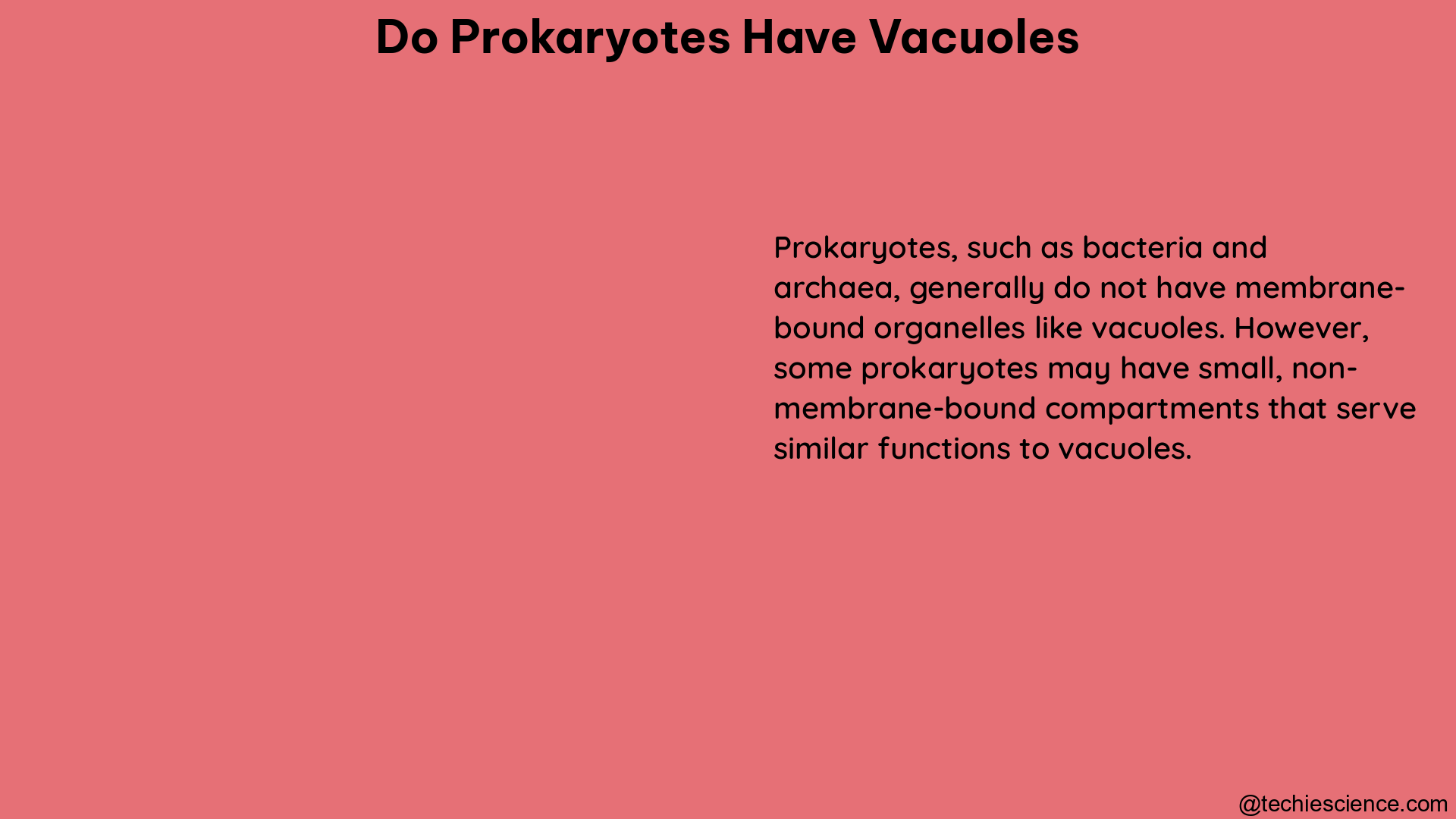Prokaryotes, which include bacteria and archaea, are single-celled organisms that lack a true nucleus and membrane-bound organelles, unlike their eukaryotic counterparts. One of the key differences between prokaryotic and eukaryotic cells is the presence or absence of vacuoles. In this comprehensive blog post, we will delve into the intricacies of prokaryotic cell structure and explore whether these organisms possess vacuoles.
Vacuoles in Eukaryotic Cells
Before we discuss the absence of vacuoles in prokaryotes, it’s essential to understand the role and function of vacuoles in eukaryotic cells. Vacuoles are large, membrane-bound organelles that serve various purposes, including:
- Storage: Vacuoles can store a variety of substances, such as water, nutrients, waste products, and even pigments.
- Waste Disposal: Vacuoles can sequester and store waste products, preventing them from accumulating in the cytoplasm and potentially harming the cell.
- Osmoregulation: Vacuoles play a crucial role in maintaining the cell’s turgor pressure, which is essential for the structural integrity and shape of the cell.
- Autophagy: Vacuoles can engulf and digest damaged or unwanted cellular components, a process known as autophagy, which is important for cellular homeostasis and recycling.
Eukaryotic cells, such as those found in plants, animals, and fungi, typically have one or more large, central vacuoles that occupy a significant portion of the cell volume.
Absence of Vacuoles in Prokaryotes

In contrast to eukaryotic cells, prokaryotic cells, including bacteria and archaea, do not possess membrane-bound vacuoles. Prokaryotic cells lack the complex internal membrane system that is characteristic of eukaryotic cells, and as a result, they do not have the specialized organelles found in eukaryotes, such as mitochondria, endoplasmic reticulum, and Golgi apparatus.
However, this does not mean that prokaryotic cells are entirely devoid of any internal compartmentalization or specialized regions. Prokaryotic cells do have distinct regions within their cytoplasm where specific functions are carried out, but these regions are not enclosed by membranes in the same way as eukaryotic organelles.
Nucleoid Region
One of the most notable regions within a prokaryotic cell is the nucleoid region, which is the area where the genetic material (DNA) is located. The nucleoid region is not surrounded by a nuclear membrane, as in eukaryotic cells, but rather occupies a specific area within the cytoplasm.
The DNA in prokaryotic cells is typically a single, circular molecule that is not associated with histone proteins, as is the case in eukaryotic cells. Instead, the DNA is compacted and organized through the action of various proteins and supercoiling.
Plasmids
In addition to the main chromosomal DNA, some prokaryotes may also possess small, circular DNA molecules called plasmids. Plasmids are extrachromosomal genetic elements that can provide additional genetic information and confer specific advantages to the host cell, such as antibiotic resistance or the ability to metabolize certain compounds.
Plasmids are not enclosed within a membrane, but they are distinct from the main chromosomal DNA and can be replicated and segregated independently during cell division.
Membrane-Bound Regions
While most prokaryotic cells do not have membrane-bound organelles, there are a few exceptions where simple membrane-bound regions can be found. For example, some photosynthetic bacteria, such as cyanobacteria, have internal membrane systems that are involved in the process of photosynthesis.
These membrane-bound regions, however, are not equivalent to the complex, membrane-bound organelles found in eukaryotic cells. They are more akin to specialized regions within the cytoplasm, rather than true, membrane-enclosed organelles.
Functional Equivalents in Prokaryotes
Although prokaryotic cells lack the membrane-bound vacuoles found in eukaryotic cells, they have developed alternative mechanisms to perform similar functions. These functional equivalents in prokaryotes include:
-
Storage Granules: Prokaryotic cells can store various substances, such as lipids, polysaccharides, and even inorganic compounds, in the form of small, dense granules within the cytoplasm. These granules serve as storage compartments and can be mobilized as needed.
-
Gas Vesicles: Some prokaryotes, particularly certain types of cyanobacteria and archaea, possess gas-filled structures called gas vesicles. These structures help the cells regulate their buoyancy and position within the water column or soil.
-
Inclusion Bodies: Prokaryotic cells can also form inclusion bodies, which are dense, non-membrane-bound aggregates of proteins or other macromolecules. These inclusion bodies can serve as storage compartments or as a means of sequestering potentially harmful substances.
-
Periplasmic Space: In Gram-negative bacteria, there is a region between the inner and outer cell membranes called the periplasmic space. This space can serve as a storage compartment and a site for various enzymatic reactions.
While these structures and regions within prokaryotic cells do not have the same level of complexity or functionality as the membrane-bound vacuoles in eukaryotic cells, they demonstrate the adaptability and resourcefulness of prokaryotes in addressing their cellular needs.
Conclusion
In summary, prokaryotic cells, including bacteria and archaea, do not possess membrane-bound vacuoles like those found in eukaryotic cells. Instead, prokaryotes have developed alternative mechanisms and specialized regions within their cytoplasm to perform similar functions, such as storage, waste disposal, and osmoregulation. The absence of membrane-bound organelles is a defining characteristic of prokaryotic cells and a key difference between the cellular organization of prokaryotes and eukaryotes.
Reference:
- Byjus – Does a Prokaryote Have a Vacuole?
- Nature – Definition of Prokaryote
- Study.com – Do Prokaryotic Cells Have a Nucleus?
- Microbiology Society – Prokaryotic Cell Structure
- Khan Academy – Prokaryotic Cells

Hello, I am Bhairavi Rathod, I have completed my Master’s in Biotechnology and qualified ICAR NET 2021 in Agricultural Biotechnology. My area of specialization is Integrated Biotechnology. I have the experience to teach and write very complex things in a simple way for learners.